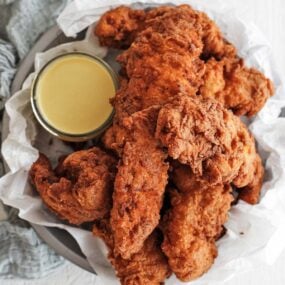

Chicken Tenders
This Chicken Tenders recipe brings restaurant-style strips home with a buttermilk brine and deep-frying for maximum crispiness.
Ingredients
For the Marinade:
- 2 pounds chicken tenders
- 1 ½ cups buttermilk
- ¼ cup pickle juice, or white distilled vinegar
- 1 tablespoon hot sauce
- 1 ½ tablespoons garlic granules
- 1 ½ tablespoons onion granules
- 2 teaspoons paprika
- 2 teaspoons coarse salt
- 1 teaspoon ground black pepper
For the Breading:
- 1 cup all-purpose flour
- 1 cup cornstarch
- 1 tablespoon baking powder
- 2 teaspoons garlic granules
- 2 teaspoons onion granules
- 2 teaspoons paprika
- 3 teaspoons coarse salt
- 1 teaspoon ground pepper
- 4 large eggs
- ½ cup buttermilk
- oil for frying
Instructions
For the Marinade:
- Add all the ingredients to a large bowl and thoroughly mix to combine. Cover and place the tenders in the fridge to marinate for 2 to 24 hours. The longer, the more flavorful and tender they will become.
For the Breading:
- In a cake tin or wide shallow bowl, whisk together the flour, cornstarch, baking powder, garlic granules, onion granules, paprika, 2 teaspoons of salt, and ½ teaspoon of pepper. Set it to the side.
- In a separate cake tin or a wide, shallow bowl, whisk together the eggs, buttermilk, and the remaining 1 teaspoon of salt and ½ teaspoon of pepper until well combined. Set it to the side.
- At this stage, add enough oil to a 4- or 5-quart pot to fill it halfway. Heat it over medium to low heat until it reaches 375°F. Keep it at that temperature. Once the cold tenders are added to the oil, the temperature will immediately drop to 350°, which is perfect.
- Take the tenders out of the fridge and remove them a few at a time. Drain off any excess, then dip them right into the seasoned flour. Press down on the tender from all sides to ensure it’s evenly coated. Lift it, shake off any excess, then over to the egg wash. Coat it on all sides, completely covering the flour in the whisked eggs. Now, drain off any excess liquid, as before, and return to dredging the flour, pressing down to completely cover it.
- Place them on a rack over a sheet tray and let them sit for up to 15 minutes, then repeat the process to bread the remaining tenders.
- Next, place the tenders 4 to 6 at a time into the hot oil. Cook them for 3 ½ to 4 minutes while flipping them every 2 minutes. They should be golden brown and cooked throughout. Set them aside on a rack to drain off any excess oil while you cook the remaining tenders in batches. They will hold fine while you do this.
- Serve with optional dipping sauces of ranch, blue cheese, or honey mustard.
Notes
Try not to let your oil temperature drop too much while you’re frying the tenders. The cold tenders will naturally lower the temperature from 375°F to 350°F, which is also the ideal temperature for fried chicken. Use a candy thermometer or instant-read thermometer to help you track, manage, and adjust the temperature as you go.
Marinating time: I recommend marinating the chicken tenders for at least 2 hours, although soaking them overnight will yield the most tender and flavorful results.
Don’t overcrowd the pot: This will surely drop the oil temperature and lead to greasy, soggy tenders. Always fry the chicken in batches for the best results.
Rest the chicken before and after cooking: Resting the double-dredged chicken for 15 minutes before frying will help the flour coating adhere to the meat. After frying, rest the chicken on a wire rack (not on paper towels) to allow the natural juices time to reabsorb into the meat. This will make every bite nice and juicy.
Make-Ahead: Deep-fried chicken tenders are best served right away. However, you can keep them warm by placing the wire rack with the chicken in a 200ºF oven for up to 30 minutes before serving.
How to Store: Once cooled, transfer the leftover tenders to an airtight container and refrigerate them for up to 4 days. Keep them crispy by placing a paper towel underneath the chicken in the container; it will absorb any excess moisture.
How to Reheat: Reheat the chicken tenders in a 375°F oven or air fryer until warmed through and crispy again.
Nutrition
Calories: 521kcalCarbohydrates: 34gProtein: 37gFat: 25gSaturated Fat: 3gPolyunsaturated Fat: 6gMonounsaturated Fat: 14gTrans Fat: 0.1gCholesterol: 155mgSodium: 2378mgPotassium: 919mgFiber: 2gSugar: 2gVitamin A: 345IUVitamin C: 4mgCalcium: 156mgIron: 2mg